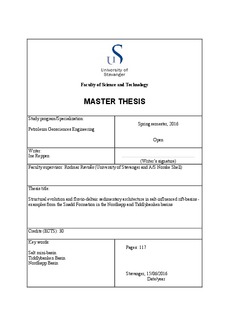| dc.contributor.advisor | Ravnås, Rodmar | |
| dc.contributor.advisor | petroleumsgeologi | |
| dc.contributor.advisor | petroleum geosciences engineering | |
| dc.contributor.author | Reppen, Ine | |
| dc.date.accessioned | 2016-10-12T13:44:43Z | |
| dc.date.available | 2016-10-12T13:44:43Z | |
| dc.date.issued | 2016 | |
| dc.identifier.uri | http://hdl.handle.net/11250/2414744 | |
| dc.description | Master's thesis in Petroleum geosciences engineering | nb_NO |
| dc.description.abstract | The Nordkapp and Tiddlybanken basins are examples of salt sedimentary basins with thick successions of Triassic-Middle Jurassic fluvio-deltaic basin infill in the Barents Sea. The Middle to Upper Triassic Snadd Formation represent two regressive-transgressive fluvio-deltaic mega-sequences systems extending across the entire Barents Sea. These large fluvio-deltaic systems were generated as a result of the exposure of the Ural Mountains and Fennoscandia.
The Nordkapp and Tiddlybanken basins formed during Devonian to Carboniferous, with salt deposited in a shallow evaporitic basin during the Late Carboniferous and Early Permian under the influence of regional extension. Salt growth was initiated in Early-Middle Triassic in the Nordkapp Basin and Middle Triassic in the Tiddlybanken Basin. Several salt mini-basins were formed due to diachronous salt growth in response to differential loading in the Early to Middle Triassic, because of the initial progradation of fluvio-deltaic systems. The fluvial stratigraphic architecture and style in the mini-basins is controlled by the interplay between subsidence rate (and subsequent accommodation creation) and sediment delivery rate.
The regressive and transgressive mega-sequences represent two forestepping to backstepping fluvio-deltaic clastic wedges in the Snadd Formation. Depositional environments range from upper delta plain to marine environments, but are mostly occupied by flood- and delta plain environments with various types of fluvial channel systems.
The salt diapirism interaction with the fluvio-deltaic systems has generated rim-synclines along the salt walls with large fluvial systems captured by the rim-synclines, resulting in fill-spill infill pattern of the salt mini-basins. In the lower progradational and retrogradational units the dominant fluvial character is meandering to anastomosing, with underfilled conditions in the salt mini-basins. The middle part is a succession with balanced to overfilled basin conditions with vertically stacked channel fills with broad meandering to braided systems/channel complexes. The upper part is dominantly balanced to underfilled, with meandering and anastomosing fluvial styles. A lacustrine environment is also identified within this package. With a greater net-to-gross and channel proportion in the middle part, this is expected to have a good to excellent reservoir quality potential. The dominantly fine-grained under and overlaying parts, seal potential stratigraphic traps such as fluvial channels in the mini-basin and/or updip along a structure. Organic-rich deposits are expected within the lacustrine environment, which have the opportunity to act as a potential source rock for the embedded channels or overlaying Jurassic strata. | nb_NO |
| dc.language.iso | eng | nb_NO |
| dc.publisher | University of Stavanger, Norway | nb_NO |
| dc.rights | Navngivelse 3.0 Norge | * |
| dc.rights.uri | http://creativecommons.org/licenses/by/3.0/no/ | * |
| dc.subject | Salt mini-basins | nb_NO |
| dc.subject | Tiddlybanken Basin | nb_NO |
| dc.subject | Nordkapp Basin | nb_NO |
| dc.title | Structural evolution and fluvio-deltaic sedimentary architecture in salt-influenced rift-basins - examples from the Snadd Formation in the Nordkapp and Tiddlybanken basins | nb_NO |
| dc.type | Master thesis | nb_NO |
| dc.subject.nsi | VDP::Technology: 500::Rock and petroleum disciplines: 510::Geological engineering: 513 | |
| dc.source.pagenumber | 117 | nb_NO |

